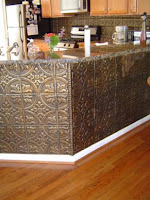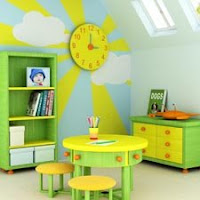Volatile organic compounds. Never heard of them? You will, especially if you've got a painting project lined up this spring. VOCs, as they are usually known, are those nasty solvents that off-gas when you paint, leaving your eyes watering and your head aching if you've been using an oil-based product and lingering as that unpleasant new-paint smell if you've slapped on less potent latex. VOCs also contribute to the formation of particulate matter and ground-level ozone, both main ingredients of smog.
The solvents are basically vehicles for transferring paint to a surface. Once applied, they evaporate and you pay the price.
The solution: low- and zero-VOC paints. They've been on the market for better than 10 years, but as a niche product with an often less-than-stellar reputation among users. Difficult to apply, with poor coverage and durability, they were good reasons not to go green. That's changing fast as the paint industry, nudged by government and green building advocates, launches new low- and zero-VOC products with superior performance.
Manufacturers are firing up zero- and low-VOC production capacity "because of demand and because it's environmentally the right thing to do," according to Jim Quick, president of the Canadian Paint & Coatings Association.
VOC content in Canadian paints has dropped 54 per cent in the past two decades, he adds, and we're likely to see that reduced by another 30 per cent in the coming years.
You need to watch for exaggerated or misleading VOC claims. For example, so-called zero-VOC paints likely contain 10 to 15 grams of VOCs per litre, according to Tom Hill, president and CEO of The Coatings Alliance. That's because EPA testing is not a precise science.
And don't be fooled by a tin of eco-innocent base or white paint: the minute you colour it, you're adding up to 20 grams of VOCs per litre thanks to the colourant. Dark paints, because they have more colourants, are also higher in VOCs than light shades.
Hill mentions a couple of still-unsolved problems with low-VOC paints.
They don't survive freeze-thaw cycles, so be careful where you store them. Also, they tend to set up quickly, so overlap marks can result unless you paint like Superman.
Rapid drying can be overcome, says Hill. "We used to say, 'Make sure you have real good ventilation.' Now we're saying to put a humidifier in the room, keep the room cooler and don't have particularly good ventilation. That will keep the paint open longer so it flows and levels better."
Patrick Langston, The Ottawa Citizen
Dave - 360renos
360renos - Home Improvement & Decor
How to make your home stand out when selling
We can help your house sell quickly and at a good price -- even in a slow market.
It takes a lot more than sparkling windows, scented candles and chocolate-chip cookies to sell a home in today's market.
Improvements should be made so that the property shows well, is consistent with the neighborhood and does not involve capital investments.
Beyond any doubt, the best investment you can make is new paint. Painting can make a room or an exterior façade look brand-new, and totally transform the look and feel of a room or the entire residence. It is always wise to be somewhat restrained when choosing colors for a home-staging paint project. Avoid choosing colors that are too individual or flashy and favor neutral colors and schemes. This does not mean painting everything white, however.
Use subtle color schemes to accentuate the home's strengths and minimize weaknesses. Dark colors, for example, tend to make a room feel smaller, while lighter colors and pastels can make a room feel bigger.
There is another benefit to painting as well: the process of preparing the interior or exterior surfaces of a home for painting automatically allows us to go over the entire area receiving paint in great detail, and this can often expose items or areas requiring repair. It seems you always discover where the caulking has let go, where the wall is dinged.
It is always preferable that we discover and deal with these items before the real estate agent (or worse, the prospective buyer) points them out to you!
Dave - 360renos
It takes a lot more than sparkling windows, scented candles and chocolate-chip cookies to sell a home in today's market.
Improvements should be made so that the property shows well, is consistent with the neighborhood and does not involve capital investments.
Beyond any doubt, the best investment you can make is new paint. Painting can make a room or an exterior façade look brand-new, and totally transform the look and feel of a room or the entire residence. It is always wise to be somewhat restrained when choosing colors for a home-staging paint project. Avoid choosing colors that are too individual or flashy and favor neutral colors and schemes. This does not mean painting everything white, however.
Use subtle color schemes to accentuate the home's strengths and minimize weaknesses. Dark colors, for example, tend to make a room feel smaller, while lighter colors and pastels can make a room feel bigger.
There is another benefit to painting as well: the process of preparing the interior or exterior surfaces of a home for painting automatically allows us to go over the entire area receiving paint in great detail, and this can often expose items or areas requiring repair. It seems you always discover where the caulking has let go, where the wall is dinged.
It is always preferable that we discover and deal with these items before the real estate agent (or worse, the prospective buyer) points them out to you!
Dave - 360renos
Saturday, March 29, 2008
Tuesday, March 11, 2008
Finding The Perfect Kitchen Backsplash

Just because kitchen backsplashes are functional doesn't mean they can't be beautiful too. Think of the strip of wall between your cabinets and countertop as a blank canvas. The design you choose for this space will have a profound impact on the look of your kitchen.
As with most trends, the shiny metal-influenced hues of the runway have made their way into home decor accessories. Metallics are everywhere, and copper is a timeless color that will add a modern look to your home.
From door handles to small and even large appliances, copper in the kitchen has extended far beyond those pots hanging from the rack.
If you’re looking for a fast and relatively inexpensive way to change the look of your kitchen, try copper on for size as a beautiful backsplash. Tin tiles are available in many colors, finishes and patterns and are a fashionable way to redress your kitchen.
From door handles to small and even large appliances, copper in the kitchen has extended far beyond those pots hanging from the rack.
If you’re looking for a fast and relatively inexpensive way to change the look of your kitchen, try copper on for size as a beautiful backsplash. Tin tiles are available in many colors, finishes and patterns and are a fashionable way to redress your kitchen.
Pressed tin kitchen backsplashes are a unique way to give your kitchen a hint of Old World charm, as they hearken back to the plasterwork styles of 19th century Europe. In fact, a kitchen backsplash made of pressed tin in a variety of patterns is one of the hottest trends in kitchen decor today. Tin is easy to clean and will stay looking great for several years.
Dave - 360renos
Friday, March 7, 2008
Prime Before Painting For Better, Longer-Lasting Results.

Priming before you paint can make a world of difference on the outcome of your paint job. Please remember to read all label directions as not all projects recommend the use of a primer. These may include surfaces such as painting a floor or staining a deck.
What can be so important about priming a surface? Primers serve two major functions: they seal porous materials so the topcoat won't dry with an uneven appearance and they aid the topcoat in bonding properly with the surface underneath.
The two main types of primers are primer-sealers and undercoaters. Unpainted surfaces, or surfaces where most of the original paint has been removed call for a primer sealer. Undercoaters should be used to form a bond between coats of paint.
Know your surface and choose the primer accordingly. For standard drywall surfaces, latex primers are better because they don't raise the nap or fibers on the surface of the wall board. For plaster surfaces, a latex or alkyd primer can be used. Alkyd undercoats are appropriate for wood trim.
For best results when painting over wallpaper, use an alkyd primer or alkyd primer/undercoater to seal potential bleedthrough and seals.
Once you have selected and applied the appropriate primer, you are ready to paint a topcoat. And because you took the time to prime, your finished paint job will be more attractive now and in the future.
Dave - 360renos
Saturday, March 1, 2008
Remodeling Ideas for Your Child's Room

Paint a Mural
If you are especially creative and love to paint, design a mural for your child's room. This is an especially fun remodeling idea as an alternative to painting the room a solid color or using wallpaper. It can be anything your child likes, and can also be personalized. If you are not a painter, you can hire a professional and the two of you can create a design idea.
Make the Room Bigger
Often, parents will choose a smaller room in the house for their child's nursery. However, as the child grows, so do their interests, and they might want to spend more time in their room playing. As they grow older, they make like to have more time to themselves. Thus, it is important that parents make the room bigger, and this can be done in a variety of ways.
First of all, consider where the room is located in the house. If it is located at the back of the house, consider knocking down the wall and extending the room that way. If the room is in the middle of the house, consider knocking down the wall of an adjoining room and thus joining the two rooms together.
Get Your Child's Input
The most important thing about remodeling is to be sure that the child has some input as to how the room will look. After all, it is going to be his/her room, and being able to have input gives a sense of pride and accomplishment. This will, of course have to be a compromise between the parents and the child.
Dave - 360renos
Subscribe to:
Posts (Atom)
